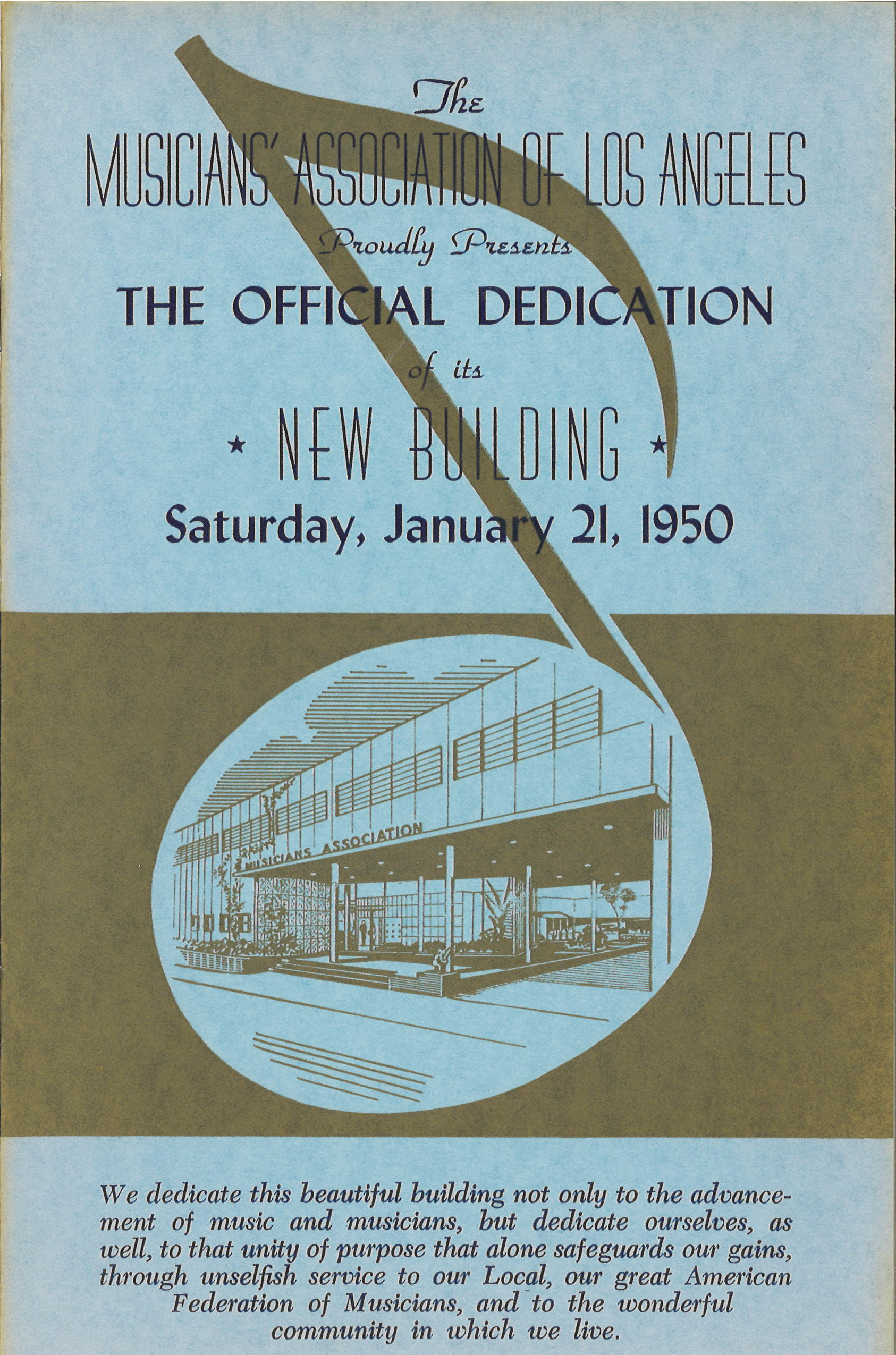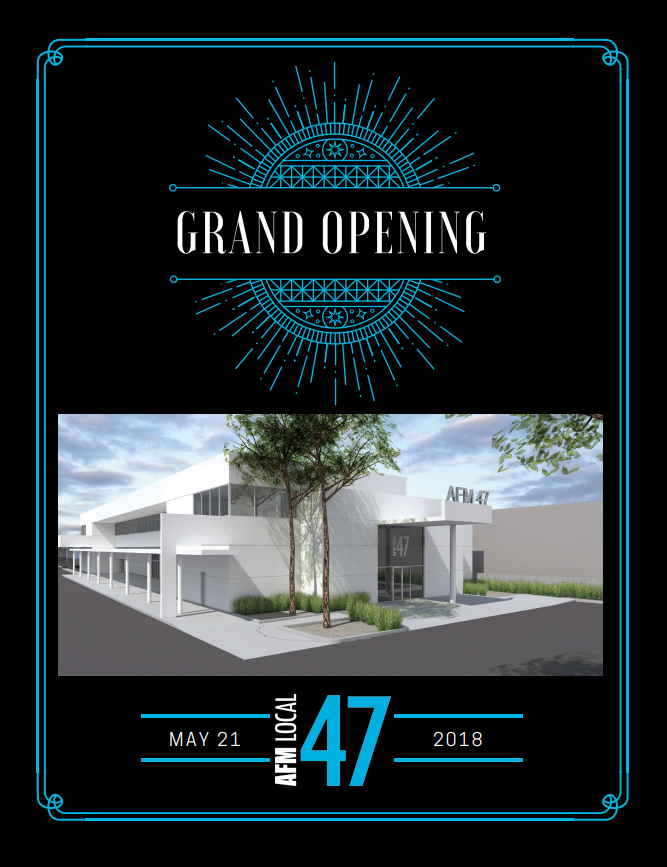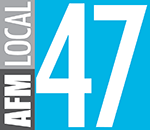Our History



-
1870: The National Association of Musicians, the first musicians' organization, is founded. The Association lasted about four or five years and left no printed records.
-
May 1886: The National League of Musicians of the United States is organized by delegates from New York, Philadelphia, Cincinnati, Chicago, Boston, Milwaukee and Detroit. The League grew to about 100 locals but was against affiliating with the general labor movement. Conventions of the League defeat every proposition to affiliate; the final defeat took place in May of 1886.
- 1881: The City of Los Angeles turns 100 and houses a population of just over 10,000.
- 1876: The Southern Pacific Railroad connects Los Angeles and San Francisco, increasing both the general population and the number of musicians settling in Los Angeles.
-
1888: The Musical Protective Association, the first musicians’ union in Los Angeles, is formed by conductor Harley Hamilton as its first president, and became Local 19 in the National League of Musicians. It lasts until 1890.
-
1890: The population of Los Angeles reaches 51,000.
-
1892: Los Angeles’s first professional orchestra, a 37-member Philharmonic, is founded by A.J. Stamm, with Harley Hamilton as concertmaster.
-
October 30, 1894: The Los Angeles Musical Society is organized in the rooms of the Republican Club at Second and Main Streets, what was then called the Rawson Block. The name was soon changed to The Los Angeles Musical Association and became affiliated with the National League of Musicians as Local No. 19. W.F. Arend is the first president. The first Local 19 directory lists 114 members, including six women.
-
December 1894: The Union begins meeting in Stuttig's Hall in the rear of a saloon at 310 South Spring, which becomes its first permanent headquarters.
-
1896: Musicians begin meeting in rooms on the first floor of the Eureka Hotel at 242 1/2 South Main Street.
-
October 19, 1896: Members of the National League of Musicians who want to affiliate with the general labor movement, acting with advice and assistance of the late Samuel Gompers, call a convention of their own to organize the American Federation of Musicians, affiliates with the American Federation of Labor. Many locals in the unaffiliated League apply for charters in the Federation. The League tries to bar Federation supporters from their convention, but the Federation obtains an injunction against their actions. From that moment on, the Federation grows in size and power and soon completely controlled the music business.
-
March 15, 1897: Local 19 is approved for membership by the American Federation of Musicians. Its new charter designates the Los Angeles musicians union of the AFM as Local 47.
- 1897: The Los Angeles Symphony is founded by Harley Hamilton and impresario L.E. Behymer.
-
September 1898: Headquarters is established in the Rawson Block which maintains a lunchroom, bar and pool table to defray the expense of $30 a month rent.
-
January 1899: The union moves to the Odd Fellows Building at 220 1/2 South Main Street where the Local paid $8 a month rent.
-
1900: Local 47's name is changed to Musicians Mutual Protective Association. The population of Los Angeles exceeds 100,000. Theater orchestras are prize jobs, with wages averaging $50-80 per week.
-
March 1901: Headquarters move once again to the Council of Labor Hall at 435 South Spring Street, where rent was $5 a month. Here the Board of Directors holds its first official meeting on April 2, 1901.
-
September 1, 1901 The union moves to a room in teh Caledonia Hall at 119 1/2 South Spring Street.
-
1904: The union sets the first wage scales (minimum prices) for orchestras traveling with comic operas, musical comedies and similar shows and attractions.
-
1907: On behalf of composers and the AFM, operetta composer Victor Herbert appears before the U.S. Congress in support of copyright reforms.
-
February 1907: Local 47 moves to the Workman Building at 230 1/2 South Spring on the third floor where they made headquarters with the San Gene Club.
-
1908: Motion picture arrives in Los Angeles. Within a decade a huge industry develops, providing added employment for musicians along with other artists and craftspeople. The industry serves as Southern California’s largest employer for many years, and to this day employs a significant number of workers.
-
June 1909: Headquarters relocate to the third floor of the old Turner Hall, beter known as Music Hall, located at 231 South Spring Street.
-
1912: Baron Long opens the Vernon Country Club, the first all-night club in Southern California, kicking off a booming scene which lasted until World War II. Bandleaders and singers became stars, and a decade later when live radio broadcasts originated from the clubs, they became bigger stars.
-
1913: The AFM and the International Association of Theatrical Stage Employees (I.A.T.S.E.) sign an agreement to support each other during controversies in theaters. Musicians begin to be hired to play
“atmosphere” music on silent film sets and
to appear on camera as “sideline” musicians, a practice that continues today
-
September 1913: Local 47 moves to the Germain Building.
-
1918: The AFM wages a campaign to prevent passage of the 18th Amendment, also known as the "Prohibition Amendment." To support the war effort, Congress adopts a 20% "Cabaret Tax" on admissions to various entertainment establishments. Both Prohibition and the Cabaret Tax decreased employment for musicians.
-
1919: The AFM works to change immigration rules for musicians, arranging for easier access for musicians traveling between the U.S. and Canada, while curtailing unregulated admission to the U.S. of foreign musicians working for poor wages.
-
February 1921: Headquarters moves to the ninth floor of the Union League Building at Second and Hill streets.
-
1922: The AFM publicizes its opposition to child labor.
-
May 26, 1926: Local 47 musicians assemble in gala splendor and from the Union League Building, marches to the new headquarters building at 1417 Georgia Street.
-
1927: The first "talkie," The Jazz Singer, is released, displacing orchestras in movie theaters. The AFM has its first encounter with wholesale unemployment brought about by technology. Within three years, 22,000 theater jobs for musicians who accompanied silent movies are lost, while only a few hundred jobs for musicians performing on soundtracks are created by the new technology.
-
1928: While continuing to protest the loss of jobs due to the use of "canned music" with motion pictures, the AFM sets minimum wage scales for Vitaphone, Moviephone and phonograph record work. Because synchronizing music with pictures for the movies was particularly difficult, the AFM was able to set high prices for this work.
-
1930: Still working to save the jobs of musicians who played music for silent movies, the union establishes the Music Defense League to gain public support for its fight against "canned music" in movie theaters.
-
1938: The AFM begins licensing recordingcompanies to ensure a union-only hiring policy. Showman Earl Carroll opens the world’s largest supper club at 6230 Sunset Blvd.
-
1939: Local 47 membership reaches 6,000. Within a year the musicians union of Los Angeles becomes the largest trade union in Southern California.
-
1940: James Petrillo is elected AFM President. He was to become a famous and pivotal figure in the union's development. Petrillo struggled to find ways to compensate the thousands of musicians who continued to lose work because of recording. As a result of his efforts, the AFM and the recording companies agreed to create the Recording and Transcription Funds (now called the Music Performance Trust Fund) which continues today to promote music appreciation and music education through sponsorship of free public performances throughout the U.S. and Canada.
-
1940s - 1960s: During this "Golden Era" of Hollywood, Local 47 musicians could be found playing at legendary venues all over Los Angeles. (Read more about the history of live music and Local 47.) Television ownership explodes from 400 sets in 1946 to 850,000 by 1951, and the new medium creates
many new opportunities for studio musicians. Within this time period Local 47 membership reaches its peak of 18,000.
-
January 21, 1950: Local 47 celebrates moving to a new location at 817 N. Vine Street in Hollywood with a Dedication Day ceremony attended by several hundred musicians, dignitaries and celebrity guests including Bob Hope, Jimmy Durante, Bing Crosby and Les Brown. The event was broadcast on national television and across international radio airwaves. Designed by master architect Gordon B. Kaufmann, the 33,000 square-foot building encompassed two stories and a basement which served as the union’s clubhouse and official headquarters. In addition to office spaces, it boasted a large auditorium and lounge which opened into an interior patio, a large recreational room, and several soundproof rehearsal halls.
(See the Dedication Day program | Listen to the original radio broadcast recording)
-
Mid-1950s: Rock ‘n’ roll sends shockwaves throughout the world. Local 47, like other Locals throughout the Federation, faced the question of whether to accept rock musicians with limited training and skills, many of whom were musically illiterate and could not pass the conventional union audition. Financial considerations prevailed and the rolls of Local 47 grew even more.
-
1951: The Lester Petrillo Fund for Disabled Musicians is created by President James Petrillo in memory of his late son.
-
April 1, 1953: The previously segregated Los Angeles musicians unions — the black Local 767 and white Local 47 — merge, setting the precedent for all other Locals throughout the Federation to end segregation. Local 767 officers Marl Young, Bill Douglass and Buddy Collette later become officers of Local 47. Read more about the amalgamation of the two Locals.
-
1959: Through negotiations with the record industry, the first AFM pension (AFM Employers' Pension Welfare Fund) is established.
-
1961: The Taskforce for Employment of Musicians Promotional Organization (TEMPO) is established as the Federation's political action committee.
-
May 1962: Local 47's name is changed to Musicians' Union Local 47.
-
1969: The AFM recognizes the International Conference of Symphony and Opera Musicians (ICSOM) as an organization representing orchestral musicians within the union.
-
1975: The AFM recognizes the Organization of Canadian Symphony Musicians (OCSM) as an organization representing orchestral musicians within the union.
-
1982: The AFM recognizes the Recording Musicians Association (RMA) as an organization representing recording musicians within the union.
- 1984 Serena Kay Williams breaks ground as the first woman to win the office of Secretary/Treasurer in 1984, a position she held until her retirement in 2007.
-
1984: The AFM recognizes the Regional Orchestra Players Association (ROPA) as an organization representing orchestral musicians within the union.
-
1986: The largest contiguous AFM Local in the nation outside of Alaska is created when Inland Empire Local 167 merges with Local 47.
-
Sept. 13, 1992: A fire, later determined to be arson, races through Local 47 headquarters, causing over $500,000 in damages. Computer systems, files and archives are destroyed, and part of the ceiling melted. Fortunately, an employee had taken back-up computer files home that weekend. Offices were rebuilt, but quarters were cramped for quite some time.
-
1994: On the occasion of its 100th anniversary, Local 47 changes its name to Professional Musicians.
-
July 1995: Local 47's name is changed to Professional Musicians, Local 47.
- 1996 The Theater Musicians Association holds its first international conference. The TMA SoCal chapter is recognized the following year.
- Dec. 7, 1998: Hal Espinosa is elected as Local 47's first Latino president.
- October 2013: Local 47 changes its name once more, to American Federation of Musicians Local 47.
- Dec. 9, 2014: John Acosta is elected as Local 47's first president of Afro-Cuban and Puerto Rican descent.
- Feb. 1, 2016: In a mail referendum, members vote to approve the sale of the Vine Street property and move the Local's headquarters to Burbank.
- July 14, 2017: Local 47's 817 Vine Street location closes its doors, and on the following Monday opens at its new headquarters at 3220 Winona Avenue in Burbank. The building, designed by architect John Cambianica and built by McCormick Construction,
- May 21, 2018: Local 47 celebrates its move to Burbank with a Grand Opening celebration and building dedication ceremony. The event is attended by more than 300 musicians, dignitaries and guests. (See the Grand Opening program book)
- Dec. 8, 2020: Stephanie O'Keefe is elected as the first woman president of our union, along with Danita Ng-Poss as Secretary/Treasurer, the first person of Asian descent to serve in an executive office. This administration took office on Jan. 11, 2021.



